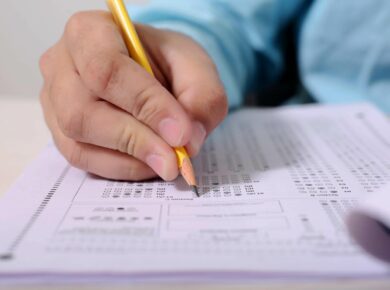From the time children are born, their parents try to figure out what their favorite foods are, what their general likes and dislikes are, and what works best for them. This continues all the way to their kids’ start of school.
Determining what type of learner your child is can take some time, but it is most definitely worth it. Understanding how our child receives information and learns can assist us in helping them accomplish their goals both inside and outside the classroom. There are many successful ways to learn, so parents must determine which method works best for their children.
What Is Learning?
The Oxford dictionary defines learning as acquiring knowledge or skills through study, experience, or being taught. Learning happens when your child fully comprehends a subject and can apply the knowledge to their own life.
If your child can understand a topic and convey it to you using their own words and actions, they have learned it. It’s critical to understand that your child probably has a particular learning style, which is a student’s preferred method of interpreting and organizing knowledge so that they may effectively retain it.
Additionally, every learning type has its advantages and disadvantages; therefore, parents must understand their child’s learning styles and support them in maximizing their strengths. Simply watching how your kids engage with the environment helps determine what type of learner they are. Actions, interests, and preferences will also reveal details about the information processing or learning style.
Types of Learning Styles
There are eight types of learning styles, including:
- Visual
- Verbal
- Logical
- Auditory
- Social
- Intrapersonal
- Physical
- Naturalistic
Visual
If your kids show more interest in videos, pictures, and diagrams when learning, they are visual learners. You may notice that it can be challenging for them to study using conventional techniques like textbooks and lectures. Instead, your child requires visual representation to comprehend and retain information.
Children who process information visually often learn through examples and explanations. They frequently visualize things and have a strong imagination. Consider using mind maps for science, diagrams and visuals to clarify concepts, and color coding for information.
Additionally, you can locate resources made expressly for visual learners, such as audio-enhanced flashcards or online learning environments with a lot of visual content.
Verbal
Written and spoken words are the best modes of knowledge acquisition for verbal learners. If your kid is a verbal learner, you will notice they learn best when knowledge is given aloud to them.
The ability to think, solve problems, and learn through language characterizes verbal learners. They have good communication skills, are typically good listeners, have a strong memory of what they’ve read, and can easily retain spoken information.
If your kid finds language fascinating and enjoys discovering new words and inventive ways to use language, such as poetry, then chances are you have a verbal learner in your hands. They might take pleasure in reading, playing word games, learning new languages, and memorizing tongue twisters.
Logical
As the name suggests, logical learners use analytical skills to understand a certain subject. Logic, order, and steps are the keys to success for logical learners. These students are good with numbers, easily make connections, and can spot patterns.
They can examine cause and effect and comprehend abstract material with ease. They make well-organized lists and groups of information. They excel at chess-style games.
Parents of these learners can engage and motivate their kids by posing questions that need interpretation, providing lessons that enable them to solve issues, and pushing them to reach conclusions based on facts or reasoning.
Logical learners may appreciate something other than text-heavy classes; they would rather go right to the point and concentrate on the facts.
Auditory
If your kid is an auditory learner, they might comprehend vocal instructions better than written ones and prefer verbal communication to written communication. Listening in class and engaging in discussions are beneficial for auditory learners at school and home.
You can support your auditory learner in various ways, such as using online tuition classes and eliminating distractions. Another illustration is encouraging your child to read aloud.
Auditory learners gain knowledge through participating in dialogues and discussing things. Clarifying spoken instructions or written material may be beneficial. Children with this strength may study best in a calm atmosphere because excessive noise might be distracting.
Social
Due to their preference for spending much time with others, social learners are frequently viewed as social butterflies. You may notice your kids prefer group projects and teamwork activities since peer interaction helps children understand a subject more thoroughly, so they find it enjoyable.
These learners pick up knowledge by engaging with others. They excel at reading others’ emotions and facial expressions and do well in group settings. They can identify the root of interpersonal communication issues in a group situation and prefer to study with others.
The majority of social learners excel at both verbal and nonverbal communication. They frequently have a good ear for listening and are good advisors.
Intrapersonal
The opposite of a social learner who likes to work with others is an intrapersonal learner. These students want to work independently and employ self-study. They have a keen awareness of their emotions, personalities, and strengths.
So, if your child has good self-control and self-reflection and enjoys learning something new daily, they are most likely intrapersonal learners. Intrapersonal learners spend a lot of time reflecting on themselves and appreciating improving themselves. These students value calm environments in both their personal and professional life.
Physical
Does your kid love to be active? They probably are physical learners. Physical and kinesthetic learners benefit the most from hands-on learning. They are typically exceptional athletes, and some may even learn more effectively by walking while reading.
For kinesthetic learners, active participation in the learning process is required. They acquire and retain information through physical activity, testing, trial and error, and an unconventional learning environment because they are “tactile” learners.
✅ Request information on BAU's programs TODAY!
With the kinesthetic learning technique, academic work and exercise are linked. Kinesthetic learners can digest information more quickly by tapping their legs, pacing back and forth, making flowcharts, underlining notes, and more. Kinesthetic learners learn most effectively when actively participating in activities or watching simulations, presentations, and films.
Naturalistic
Naturalistic learners enjoy being able to touch and hold things. They flourish in settings where they can experience emotions and actively participate in activities. They enjoy being outside and appreciate active pursuits.
Parents can encourage this learning in their children by giving them hands-on activities, learning lessons outside when the weather permits, and using natural examples to convey new ideas.
The naturalistic child can still learn in a classroom even when they prefer being outside. Once a parent knows their kid’s preferred learning method, they can offer various prosperous, worthwhile opportunities for naturalistic learning.
Why Is It Important to Know Your Child’s Learning Style?
When you know your child’s learning styles, you can provide them with the right resources to push them toward success. Once you know the principles of each learning style, you can determine which one is more effective for your child.
You should watch your kid while they play and concentrate on their schoolwork. These observations allow you to learn about their character traits and interests. This way, you will better understand the necessary tool to use for learning.
The teacher will also be watching them, so you may work together to create an experience that fits their learning preferences. But it’s crucial to remember that kids can evolve and adapt over time. While they could be a particular kind of learner, as your child grows and changes, that could also change.
Benefits of Knowing Your Child’s Learning Style
Knowing your child’s learning style has various benefits for both the child and the parent. Let’s mention some of them.
You can find activities specific to their style
A quick internet search for a specific learning style will provide you with several at-home activities you may conduct to support your child’s education. You may type “kinesthetic learning activities” into your search engine as an example. There will be many choices, so set aside some time to peruse!
It makes learning more fun for them
Learning becomes enjoyable for children when you engage them in more activities that fit their preferred learning style. Your child will be exposed to diverse learning methods, and they’ll feel more confident to tackle more challenging subjects. If the activities are suitable for their learning, they are more likely to acquire knowledge.
You can strengthen other learning styles
While most kids might have a specific learning style, teachers cannot always adapt the lesson to each learning style. Hence, parents must expose their kids to different learning styles; the sooner, the better. A more well-rounded education with improved, more challenging learning approaches will be possible.
It strengthens your bond with your child
Your relationship with your kid will be stronger, and you’ll be able to facilitate more effective learning encounters if you are aware of their preferred learning style. Communication will improve as a result of your strong bond, and your child will feel more supported at home. This will affect their success outside as well.
Conclusion
Understanding your kid’s learning styles is crucial since it can increase their chances of academic success. Going through all the learning styles helps you recognize your child. Even so, trying to expose your children to different learning approaches is always a good idea. This way, you can also employ some of the most effective study methods while spending quality time with your kids.













